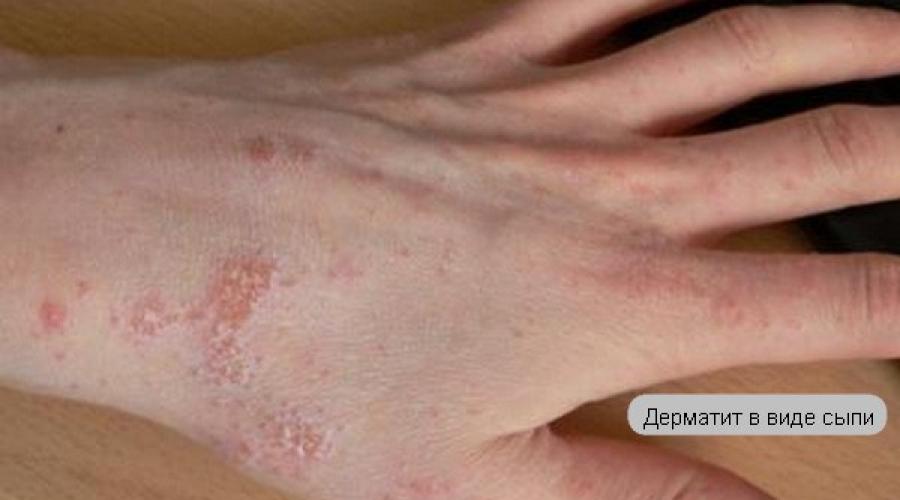How is itchy dermatitis. Ways to get rid of itching

Itchy dermatitis, prurigo, prurigo and strophulus are different names for an inflammatory process that affects the skin. It usually develops against the background of disorders of the nervous system. Any substance can be the culprit of the disease - plant pollen, food, household chemicals, pet hair, medicines, etc.
Pruritus does not stand out as a separate diagnosis. This is a collective name that combines inflammation and itching.
Based on this characteristic, the pathology is divided into several varieties of dermatitis:
- developing as a result of exposure to a substance to which the body reacts with hypersensitivity;
- contact, associated with the interaction of a certain part of the body with an irritant;
- manifested by inflammation of the sebaceous glands;
- - a kind of reaction of the body, observed mainly in children.
The main signs of itchy dermatitis
Each type of allergen is associated with a particular irritant and inflammatory process. The disease occurs in different forms, but its symptoms are often the same. At the beginning of development, pathology makes itself felt with debilitating itching. The intensity of its manifestation depends on the characteristics of the irritating substance. When the problem area looks damaged, with atopy, itching is combined with rashes.
Gradually, reddening of the integument joins the itching, which is explained by an excessive rush of blood to the capillaries. In patients with an acute form of the disease, reddened lesions look swollen. Internal hemorrhage does not occur with dermatoses, only the outer surface of the dermis turns red.
Such a sign of the disease as exudation is expressed by severe inflammation with the outflow of fluid. In advanced cases, the skin tissue flakes and cracks. Excessive dryness of the integument forces a person to constantly itch. The photo of our database clearly shows different variants of the manifestation of itchy dermatitis.




When the disease begins to progress, small bubbles appear on the body, prone to self-dissection. Their place is occupied by weeping wounds, which make it easier for pathogenic infections to penetrate the body. If the pathological tissue dies, scars remain. Sometimes signs of dermatosis are coin-like papules up to 2 cm in diameter.
Itching in the mouth indicates an allergy to metal. Irritation of the ocular mucosa indicates a negative reaction to contact lenses, dust, wool, and cosmetics. Itching of the perianal zone and genitals indicates an allergy to latex and medicines.
How does itchy dermatitis
Prurigo comes in several forms:
- acute;
- chronic;
- subacute;
- generalized.
The acute stage is manifested by abundant rashes.

Bubbles form on the red skin, the opening of which leads to weeping. Dried foci turn into serous crusts. The last stage of this stage is the peeling of the skin.
Chronic pruritic dermatitis develops from a small red spot resembling an irritated area. Not realizing that this is a sign of a skin disease, a person is in no hurry with treatment until he notices liquid elements. Bubble zones begin to itch, which leads to their damage and exudate leakage.
In subacute stage a person is tormented by unbearable itching. Excessive dryness of the skin does not bring relief from scratching the body. The tissues become inflamed and cause discomfort.
The cause of the subacute course of the disease is associated with heredity. Its symptoms are revealed on the basis of hay fever, asthma and skin rashes. If a person has a problem in childhood, regular monitoring of reactions helps to reduce symptoms.
Generalized pruritic dermatitis is the most severe course of the disease. In advanced stages, almost the entire surface of the body turns into a large pathological focus. The skin becomes red, swollen, flaky. Inflammation develops for several reasons:
Generalized strophulus makes the skin rough, thick, scaly. The body is covered with crusts and constantly itches. The body reacts to these changes by raising or lowering the temperature. Internal heat and cold are caused by inflammation and increased fluid loss.
Video: itchy dermatitis.
Ways to get rid of itching
Before removing itching with dermatitis, it is necessary to establish its exact cause. Food allergen testing is done by a dermatologist. If the provocative factor is known, the specialist develops a course to eliminate its influence. For oral administration, patients are prescribed the following groups of medicines:
- antihistamines - derivatives of fexofenadine, levocetirizine and desloratadine;
- vitamins A, C, B, E for greater effectiveness of the impact are prescribed not in a complex, but separately;
- hormonal agents are offered only to seriously ill patients.
Local treatment of itchy dermatitis in mild stages is carried out with anti-inflammatory creams and ointments - Protopic, Fenistil, Dermalex. Of the hormonal drugs, Elok or Kutiveit are prescribed, but their use is justified only in the advanced stages of the disease. Combined agents are the best option for therapy, since the combination of antibiotics, antimycotics and hormones allows you to establish all processes in the dermis and improve its condition. This group includes Triakutan, Triderm, Pimafukort.
